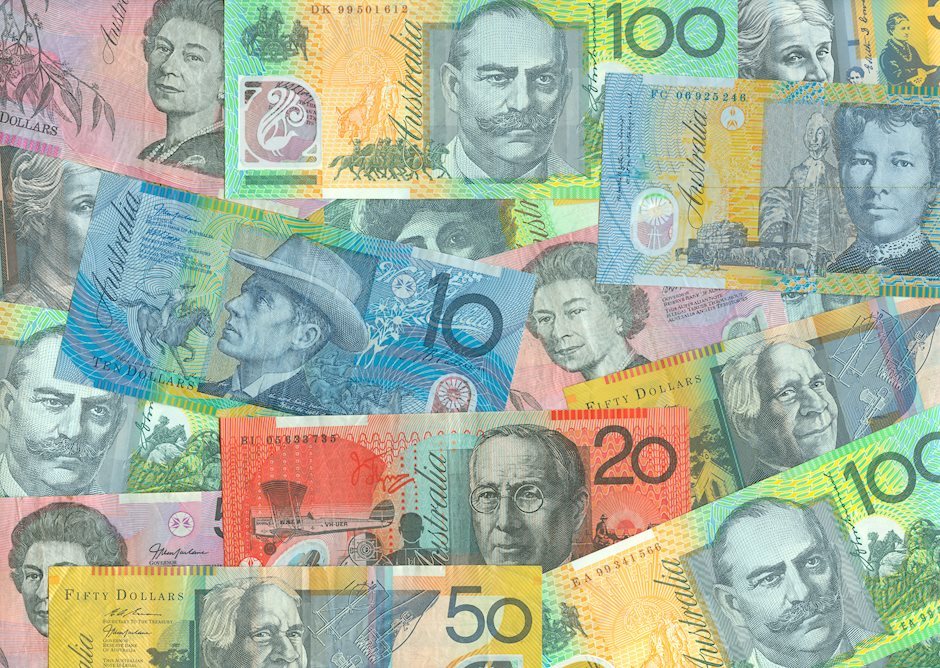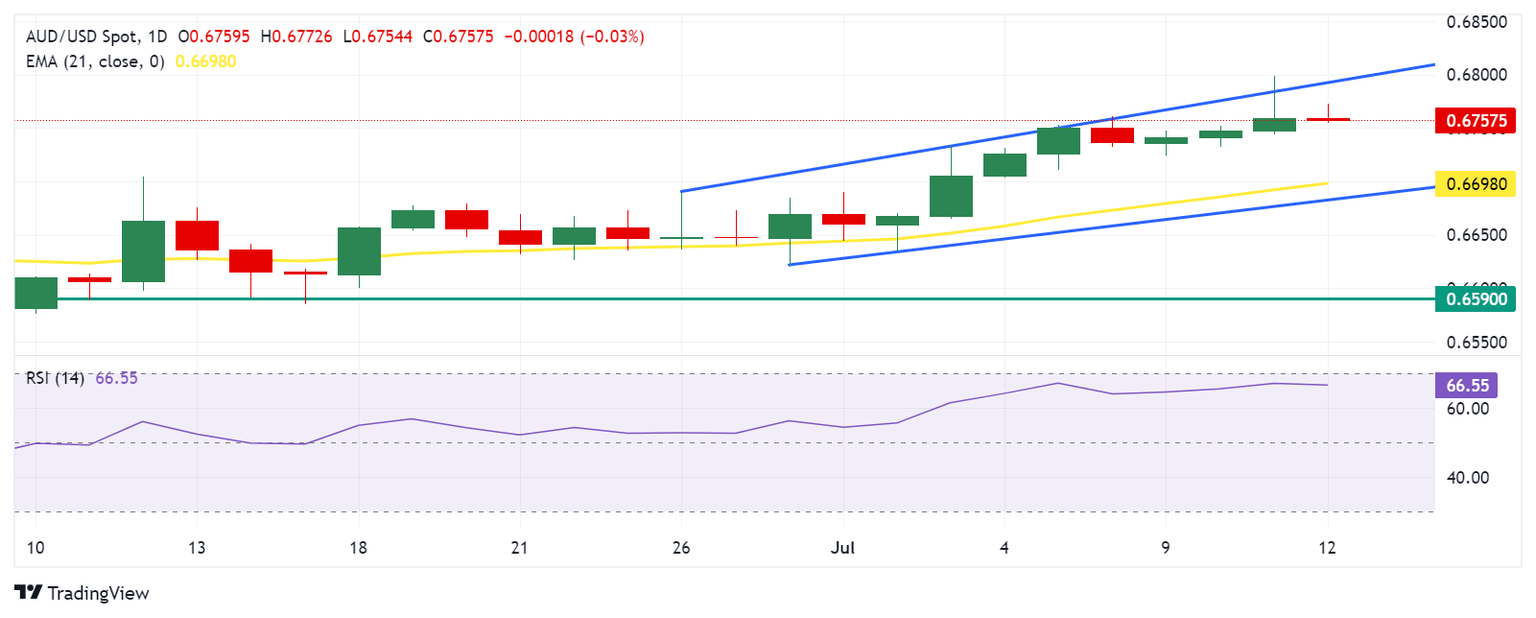Australian Dollar holds gains ahead of Michigan Consumer Sentiment Index
- The Australian Dollar recovers its losses as soft US inflation data raises expectations of Fed reducing rates.
- China's Trade Balance for June came in at $99.05 billion, widening from the previous figure of $82.62 billion.
- Fed’s Goolsbee stated that the US economy appears to be on track to achieve 2% target inflation.

The Australian Dollar (AUD) trades around its six-month high of 0.6798 recorded in the previous session. The AUD/USD pair found support as the US Dollar (USD) weakened following softer-than-expected US Consumer Price Index (CPI) data in June. This has increased expectations of a potential Federal Reserve (Fed) rate cut in September. Traders await the Michigan Consumer Sentiment Index and US Producer Price Index (PPI), due on Friday, to gain further impetus on the US economy.
Additionally, China, a close trade partner of Australia, released its Trade Balance data for June, which shows a trade surplus of $99.05 billion, widening from the previous figure of $82.62 billion. Any change in the Chinese economy could impact the Australian Dollar.
The AUD may extend its upside as speculation grows that the Reserve Bank of Australia (RBA) might delay the global rate-cutting cycle or even raise interest rates again. Persistently high inflation in Australia prompts the RBA to maintain a hawkish stance.
The US Dollar (USD) recovers its losses amid improved US Treasury yields. Investors in the fed funds futures market have increased their bets on a rate cut by the US Federal Reserve starting in September. According to CME Group’s FedWatch Tool, markets are now pricing in nearly 89% odds of a rate cut at the September Fed meeting, up from 73% on Wednesday.
Daily Digest Market Movers: Australian Dollar appreciates on risk-on sentiment
- China Exports (YoY) rose by 8.6% vs. 8.0% expected and 7.6% previous. Meanwhile, Imports (YoY) declined by 2.3% against the previous rise of 2.8%.
- Federal Reserve Bank of Chicago President Austan Goolsbee said on Thursday that the US economy appears to be on track to achieve 2% inflation. This suggests Goolsbee is gaining confidence that the time for cutting interest rates may soon be approaching. He also stated "My view is, this is what the path to 2% looks like," according to Reuters.
- The US Consumer Price Index (CPI) declined by 0.1% month-over-month in June, marking its lowest level in more than three years. On a yearly basis, the headline CPI increased by 3.0% in June, down from a 3.3% rise in May and below the market consensus of 3.1%.
- The core CPI, which excludes volatile food and energy prices, rose by 3.3% year-over-year in June, compared to May's increase of 3.4% and the same expectation. Meanwhile, the core CPI increased by 0.1% month-over-month, against the expected and prior reading of 0.2%.
- Australia's Consumer Inflation Expectations for July came in at 4.3%, slightly lower than the previous reading of 4.4%.
- Federal Reserve Board Governor Lisa Cook stated on Wednesday, "My baseline forecast...is that inflation will continue to move toward target over time, without much further rise in unemployment," according to Reuters.
- On Wednesday, Fed Chair Jerome Powell emphasized the need to closely monitor the labor market, noting that it has significantly deteriorated. Additionally, Powell expressed confidence in the downward movement of inflation.
- On Tuesday, Fed Chair Jerome Powell answered questions before the Senate Banking Committee on the first day of his Congressional testimony. Powell stated, "More good data would strengthen our confidence in inflation." He emphasized that a "policy rate cut is inappropriate until the Fed gains greater confidence that inflation is headed sustainably toward 2%." He also noted that "first-quarter data did not support the greater confidence in the inflation path that the Fed needs to cut rates."
Technical Analysis: Australian Dollar hovers around 0.6750
The Australian Dollar trades around 0.6760 on Friday. The analysis of the daily chart shows that the AUD/USD pair consolidates within an ascending channel, indicating a bullish bias. Furthermore, the 14-day Relative Strength Index (RSI) remains above the 50 level, confirming the ongoing bullish momentum.
The AUD/USD pair may retest the upper boundary of the ascending channel at approximately 0.6790 and the psychological level of 0.6800.
On the downside, the AUD/USD pair may find support around the 50-day Exponential Moving Average (EMA) at 0.6698. Further support appears around the lower boundary of the ascending channel at 0.6680. A break below this level could push the pair toward the throwback support around 0.6590.
AUD/USD: Daily Chart
Australian Dollar PRICE Today
The table below shows the percentage change of Australian Dollar (AUD) against listed major currencies today. Australian Dollar was the strongest against the Japanese Yen.
| USD | EUR | GBP | JPY | CAD | AUD | NZD | CHF | |
|---|---|---|---|---|---|---|---|---|
| USD | -0.02% | -0.01% | 0.05% | -0.07% | -0.16% | -0.12% | -0.03% | |
| EUR | 0.02% | 0.02% | 0.12% | -0.06% | -0.15% | -0.11% | -0.04% | |
| GBP | 0.00% | -0.02% | 0.10% | -0.09% | -0.18% | -0.13% | -0.06% | |
| JPY | -0.05% | -0.12% | -0.10% | -0.20% | -0.25% | -0.21% | -0.13% | |
| CAD | 0.07% | 0.06% | 0.09% | 0.20% | -0.08% | -0.04% | 0.02% | |
| AUD | 0.16% | 0.15% | 0.18% | 0.25% | 0.08% | 0.05% | 0.12% | |
| NZD | 0.12% | 0.11% | 0.13% | 0.21% | 0.04% | -0.05% | 0.08% | |
| CHF | 0.03% | 0.04% | 0.06% | 0.13% | -0.02% | -0.12% | -0.08% |
The heat map shows percentage changes of major currencies against each other. The base currency is picked from the left column, while the quote currency is picked from the top row. For example, if you pick the Australian Dollar from the left column and move along the horizontal line to the US Dollar, the percentage change displayed in the box will represent AUD (base)/USD (quote).
Australian Dollar FAQs
One of the most significant factors for the Australian Dollar (AUD) is the level of interest rates set by the Reserve Bank of Australia (RBA). Because Australia is a resource-rich country another key driver is the price of its biggest export, Iron Ore. The health of the Chinese economy, its largest trading partner, is a factor, as well as inflation in Australia, its growth rate and Trade Balance. Market sentiment – whether investors are taking on more risky assets (risk-on) or seeking safe-havens (risk-off) – is also a factor, with risk-on positive for AUD.
The Reserve Bank of Australia (RBA) influences the Australian Dollar (AUD) by setting the level of interest rates that Australian banks can lend to each other. This influences the level of interest rates in the economy as a whole. The main goal of the RBA is to maintain a stable inflation rate of 2-3% by adjusting interest rates up or down. Relatively high interest rates compared to other major central banks support the AUD, and the opposite for relatively low. The RBA can also use quantitative easing and tightening to influence credit conditions, with the former AUD-negative and the latter AUD-positive.
China is Australia’s largest trading partner so the health of the Chinese economy is a major influence on the value of the Australian Dollar (AUD). When the Chinese economy is doing well it purchases more raw materials, goods and services from Australia, lifting demand for the AUD, and pushing up its value. The opposite is the case when the Chinese economy is not growing as fast as expected. Positive or negative surprises in Chinese growth data, therefore, often have a direct impact on the Australian Dollar and its pairs.
Iron Ore is Australia’s largest export, accounting for $118 billion a year according to data from 2021, with China as its primary destination. The price of Iron Ore, therefore, can be a driver of the Australian Dollar. Generally, if the price of Iron Ore rises, AUD also goes up, as aggregate demand for the currency increases. The opposite is the case if the price of Iron Ore falls. Higher Iron Ore prices also tend to result in a greater likelihood of a positive Trade Balance for Australia, which is also positive of the AUD.
The Trade Balance, which is the difference between what a country earns from its exports versus what it pays for its imports, is another factor that can influence the value of the Australian Dollar. If Australia produces highly sought after exports, then its currency will gain in value purely from the surplus demand created from foreign buyers seeking to purchase its exports versus what it spends to purchase imports. Therefore, a positive net Trade Balance strengthens the AUD, with the opposite effect if the Trade Balance is negative.
Author

Akhtar Faruqui
FXStreet
Akhtar Faruqui is a Forex Analyst based in New Delhi, India. With a keen eye for market trends and a passion for dissecting complex financial dynamics, he is dedicated to delivering accurate and insightful Forex news and analysis.


















